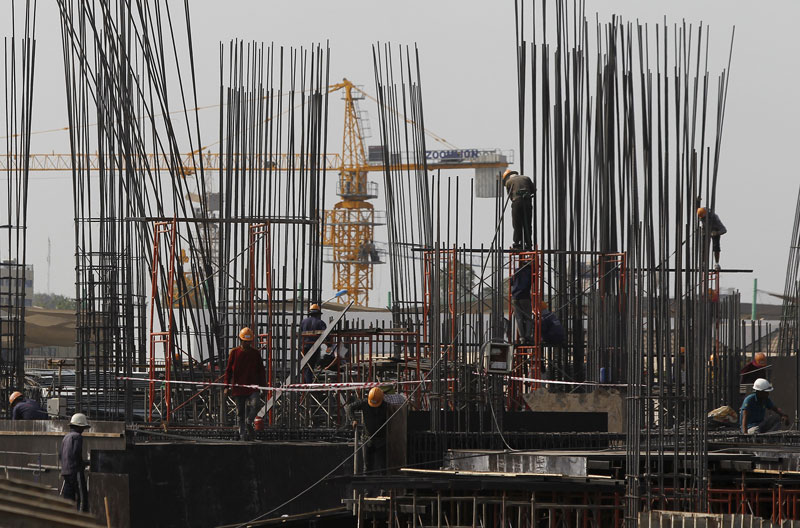The Asian Development Bank (ADB) is predicting a steady uptick in Cambodia’s economic growth to 7.3 percent and 7.5 percent in 2015 and 2016, respectively, on the strength of improved performance in the country’s trade partners and a tempered political environment at home.
The forecast is part of the Asian Development Outlook 2015, which the bank launched Tuesday and shows Cambodia continuing to outpace most of Asia and recovering from a slight dip to 7 percent growth in its gross domestic product (GDP) in 2014.

The ADB blames last year’s dip —down from an average growth rate of 7.2 percent over the previous three years—on political and labor unrest that dented both investor confidence and tourist arrivals, and on floods and droughts curbing agriculture.
At a press conference in Phnom Penh on Tuesday, ADB senior country economist Jan Hansen said Cambodia’s economy was set to speed up again thanks to last year’s political detente, appeased garment workers and a recovering global economy.
“These headwinds for the economy have eased, or started to ease,” Mr. Hansen said. “We are…expecting an increasingly positive performance by the major trading partners, by the U.S, by Thailand, and to a lesser extent by the European Union, but also because of the [easing of] political and labor tensions, the lower fuel costs…which are increasing real disposable income for households.”
The ADB says Cambodia will also benefit this year and next from robust domestic demand, a shrinking fiscal deficit, replenishing bank deposits and an improving—if still deeply negative—trade deficit. The bank also expects agricultural output to pick up modestly.
“So the Cambodian economy is in the favored position of being able to rely both on strong external and internal demand, rather than some other countries relying only on one of them,” Mr. Hansen said.
Unions and labor rights groups say workers in the critical garment and footwear sectors, which contribute roughly a third of the country’s GDP, were cowed by the government’s deadly suppression of wage protests early last year. A 28 percent hike to the sector’s minimum wage—from $100 to $128—that took effect in January also helped.
Though garment exports continue to grow, the unrest has cut sharply into orders from abroad. Mr. Hansen said rising garment worker wages, and the upward pressure they may put on other sectors, could also hurt orders.
“That is maybe a bit of a concern for the next years…. And there are also other competitors in the region joining the market and producing garments,” he said. “When it comes to rising labor costs, and also spillover effects to other sectors, rising costs throughout the economy, that is something which has to be watched over the next years.”
ADB country director Eric Sidgwick said this year’s sharp wage raise, while “reasonable” after many years of no raise at all, could also drive up expectations in the years ahead.
“Issues of industrial relations will therefore become more important,” he said.
“The fact that there was agreement [over this year’s raise], that there is more of a mechanism now for dialogue, I think one would hope that this mechanism can be used more effectively and that you have regular dialogue so that you don’t have this stop-go kind of approach where you raise the minimum wage and then you forget about it until the next crisis or the next demonstration,” Mr. Sidgwick said.
Mr. Hansen said the slowdown in the garment and agriculture sectors last year also made Cambodia’s economy more reliant on construction and real estate, “which has often proved a tendency to create economic cycles and occasionally also financial vulnerability, so this will require an increased attention by the government supervisors and regulators over the next years.”
He also urged the government to keep a close eye on the rapid rise of private credit, which rose from 45 percent as a share of GDP in 2013 to nearly 55 percent last year.
“The level is also comparatively high for a low or an upcoming low and middle income country, so this is indicating the possibility of some financial vulnerabilities for the next year,” he said.
As for Cambodia’s prospects beyond 2016, the ADB said the economy would likely continue to slowly diversify its relatively narrow economic base—perhaps most importantly into light manufacturing—and integrate into regional and global supply chains.
The ADB Outlook urges Cambodia to do more to build up its infrastructure, improve the skills of its labor force and raise the incentives for foreign investment. It says the country’s special economic zones have helped to lure investors but shown little evidence that the firms they house are significantly outperforming the firms operating outside them.
The arrival of the Asean Economic Community at the end of this year has caused jitters about Cambodia’s ability to compete as trade barriers within the region begin to fall.
Mr. Sidgwick said Cambodia was making good progress to get ready, at least on paper, and that existing barriers would in any case be coming down gradually.
“AEC is not a big bang, and the world for Cambodia will not be dramatically different on January 1 than it was on December 31,” he said.
Mr. Sidgwick and Mr. Hansen also stressed the importance of getting more Cambodians to benefit from the country’s booming economy.
Though inequality has been falling since 2007, many of the Cambodians rising above the official poverty line are just barely escaping.
“The challenge for growth for Cambodia is for that growth to be more inclusive,” Mr. Sidgwick said.
“That means more people to have access to this growth and to have access to opportunities for growth. Obviously, the higher the rate of growth the higher the chances for growth affecting more people, but it’s not automatic.”